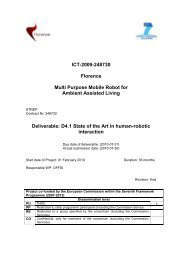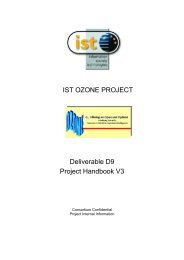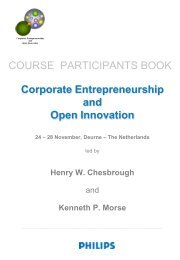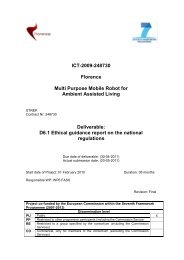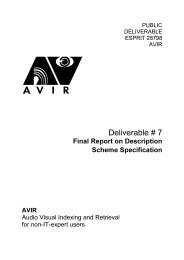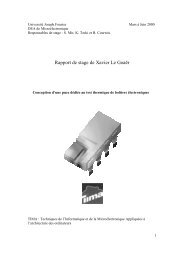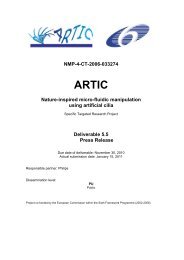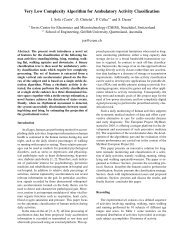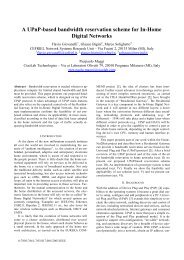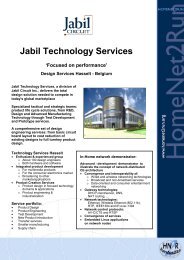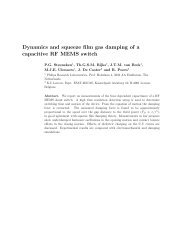presentation - Hitech Projects
presentation - Hitech Projects
presentation - Hitech Projects
You also want an ePaper? Increase the reach of your titles
YUMPU automatically turns print PDFs into web optimized ePapers that Google loves.
Nature-inspired micro-fluidic<br />
manipulation using artificial cilia<br />
Artic<br />
This work is partly funded by the European Commission in the NMP-2004-033274, ARTIC project
Nature-inspired micro-fluidic manipulation using artificial cilia<br />
Why Micro-fluidics?<br />
A European Specific Targeted Research Project<br />
pre-treatment<br />
valves, pumps<br />
sample<br />
DNA amplification<br />
electronics<br />
universal<br />
I/O<br />
detection<br />
Bath, UK<br />
Targeted diagnostics<br />
•Genomics<br />
•Proteomics<br />
•Metabolomics<br />
•Cell Bio<br />
Eindhoven, NL<br />
Groningen, NL<br />
Bucharest, RO<br />
Sample prep is key<br />
Freiburg, DE<br />
Liquids research, UK<br />
•“Sample preparation” and “micro-fluidics” are intimately connected<br />
•For complete solution, sample prep and micro-fluidics are indispensible<br />
•Philips can make a difference in micro-fluidics and sample-prep<br />
•Up to now, this has been an underestimated field within Philips<br />
Philips, NL<br />
Delft, 2 NL<br />
http://www.artic-project.eu/
Fluid propulsion in micro channels using<br />
magnetically-actuated artificial cilia: a biomimetic<br />
approach<br />
Syed Khaderi 1 , Michiel Baltussen 2 , Patrick Anderson 2 , Daniel Ioan 3 ,<br />
Jaap den Toonder 2 and Patrick Onck 1<br />
1<br />
University of Groningen, 2 Eindhoven University of Technology,<br />
3<br />
Universitatea Politehnica din Bucuresti
Fluid propulsion Why in Micro-fluidics? lab-on-a-chip<br />
Lab on a chip manufactured by Siemens<br />
pre-treatment<br />
valves, pumps<br />
DNA amplification<br />
electronics<br />
universal<br />
I/O<br />
sample<br />
detection<br />
•“Sample preparation” and “micro-fluidics” are int<br />
•For complete solution, sample prep and micro-flu<br />
•Philips can make a difference in micro-fluidics an<br />
•Up to now, this has been an underestimated field<br />
http://starcentral.mbl.edu/eutree_workshop/protistiary/rarbur/rarbur_01.htm<br />
Design externally controlled artificial cilia that can create flow in micro-channels.
Approach<br />
Questions:<br />
• Cilia geometry<br />
• Material properties<br />
• Initial configuration<br />
• Magnetic field<br />
• Flow generated<br />
Magnetostatics<br />
Solid mechanics<br />
Fluid mechanics
Super-paramagnetic cilia<br />
Periodic array of cilia<br />
Tapered cross-section<br />
Rotating magnetic field
Metachronal motion of cilia<br />
Image source: http://starcentral.mbl.edu/eutree_workshop/protistiary/rarbur/rarbur_01.htm
Metachronal motion of cilia
Summary<br />
• A tapered super-paramagnetic film mimics the<br />
beat motion of natural cilia.<br />
• Synchronously beating cilia create a<br />
fluctuating fluid flow.<br />
• Metachronal motion of cilia drastically<br />
reduces the negative flow, increasing the net<br />
fluid transport.
Fluid propulsion by cilia in a shear-thinning fluid<br />
Michiel Baltussen, Patrick Anderson,<br />
Jaap den Toonder
Background<br />
Artificial cilia Lab-on-Chip Medical diagnostics Biological fluids Saliva<br />
Saliva is a water based polymer solution -> non-Newtonian<br />
Investigate the differences between<br />
a Newtonian and a non-Newtonian fluid driven by cilia
Background<br />
• Saliva rheological data is scarce<br />
• We measured the shear-viscosity<br />
Human Whole Saliva, test of 6 different individuals:
Model<br />
Constitutive equations:<br />
-Neo-Hookean solid<br />
-Newtonian or shear-thinning fluid
Results: ciliar motion<br />
Newtonian: 0.1 Pas<br />
Shear-Thinning: saliva<br />
Forward stroke<br />
Backward stroke<br />
Motion when the flow is time periodic
Results: flowrate
Conclusions & Future Work<br />
• The motion of cilia in a shear-thinning fluid<br />
differs from the motion in a Newtonian fluid<br />
• The net flow is more sensitive to the actuation<br />
force<br />
• Perform simulations with a viscoelastic model
Fabrication of artificial rubber cilia by<br />
photolithography<br />
Jacob Belardi, Nicolas Schorr, Oswald Prucker,<br />
Stephen Wells, Vijay Patel, Jürgen Rühe
System<br />
Elastic polymer matrix filled<br />
with magnetic nanoparticles<br />
Large cilia arrays<br />
Challenge:<br />
How to generate different polymeric structures<br />
in a standard lithography process<br />
Polymeric anchoring strip
Two color lithography process<br />
Cilia<br />
Anchors<br />
MABP crosslinker<br />
OPA crosslinker<br />
H<br />
C<br />
H<br />
O<br />
O<br />
O<br />
hydrophilic surface<br />
sacrifial layer<br />
H<br />
C<br />
H<br />
O<br />
O<br />
O<br />
H<br />
C<br />
OH<br />
O<br />
O<br />
magnetic rubber/<br />
cilia structures<br />
development<br />
(rinse with toluene)<br />
H<br />
C<br />
OHO<br />
O<br />
UV-A (365 nm)<br />
hydrophilic coating<br />
release<br />
(rinse with water)<br />
UV-C (250 nm)
Artificial cilia arrays<br />
Rubber cilia<br />
- Stable – covalent attachment to surface<br />
- Very flexible<br />
- Magnetic content: 38 % by weight (TGA,XPS)<br />
Cilia arrays<br />
Hundreds of individual cilia<br />
High yield of working cilia (>99%)<br />
Variable geometry<br />
Cilia in different sizes and shapes available<br />
Integration in microfluidic channel<br />
Channel formed by substrate with cilia,<br />
PDMS casket and glass top plate
Conclusions<br />
We use photoreactive copolymers and<br />
ferrofluids to fabricate artificial cilia<br />
UV<br />
Two color lithography uses two different<br />
crosslinkers, sensitive to different types of<br />
UV-radiation<br />
The cilia consist of rubber matrix, filled with<br />
magnetic nanoparticles and are anchored to<br />
the surface with one end<br />
Large arrays of cilia were produced and high<br />
yields of working cilia were achieved<br />
The process is very flexible and allows to<br />
produce cilia with different geometries
Magnetically actuated polymer flap arrays<br />
as an example for artificial cilia<br />
Nicolas Schorr, Jacob Belardi, Oswald Prucker,<br />
Stephen Wells, Vijay Patel, Jürgen Rühe
Magnetic actuation<br />
Setup for magnetic actuation:<br />
• Closed microfluidic chamber /w cilia substrate<br />
• Rotating permanent magnet underneath chamber<br />
• Observation through microscope in top view.<br />
• Rotating magnet generates a field which rotates<br />
in the opposite direction.
Magnetic actuation<br />
• Initial position of cilia is parallel to the substrate.<br />
• Upon field rotation cilia flip into an upright position and back.<br />
Composite flaps can be actuated using rotating magnetic fields
Asymmetric motion<br />
Snapshots of a single flap taken during<br />
a half rotation cycle of the magnet<br />
Asymmetric response of the flaps in<br />
shape and response time.<br />
FLOW
Effective Flow<br />
• Z-profile follows basic parallel plate model<br />
• Velocities of up to hundreds of m/s<br />
• Effective flow rates of ~30l/min
Conclusions<br />
• Magnetically actuated artificial cilia can generate net flow in microchannels.<br />
• Effective flow rates of up to 30 l/min are possible. Such values are<br />
comparable to values found for other microfluidic pumps.<br />
• Artificial cilia do not require external connections, and are compatible with<br />
bio-fluids.
An integrated system with magnetically driven<br />
artificial cilia<br />
Bogdan Craus, Nicolas Schorr, Jacob Belardi, Jeanette<br />
Hussong, Michel Jongerius, Jaap den Toonder
Concept<br />
Epifuorescent<br />
microscope<br />
µPIV<br />
B<br />
Sketch of device for generation fluid flow:<br />
•magnetic actuation system with integrated fluidic cartridge<br />
•fluid characterization can be done by µPIV.
Approach<br />
Microfluidic device requirements<br />
• optical access for cilia and flow characterization<br />
• minimum flow resistance<br />
• reusable optical part<br />
• fluid compatibility (control of cilia hydrophobicity)<br />
• tracer particle compatibility<br />
Magnetic actuator requirements<br />
• available space limited by optical access and<br />
cartridge design 40mm X 20mm X 5mm<br />
• B > 25mT<br />
• field uniformity acceptable variation no<br />
more than 5% per cilia length. Note that<br />
quantitative measurements of local fluid velocity<br />
are possible with a resolution higher than 200μm<br />
(and better).<br />
FEM simulations<br />
100µm 100µm
Results<br />
Cilia side<br />
view<br />
through<br />
prism<br />
a) images of a cilium with increasing magnetic field applied in the vertical plane and zero<br />
background flow; the width of the cilium is 20μm; b) projected length as a function of<br />
applied field in zero and 300μL/min background flow; c) side view image of a cilium<br />
covered with fluorescent particles; d & e & f) the same cilia measured in a background<br />
flow of 300µl/min at magnetic field values of 0A/m, 12kA/m and 24kA/m
Summary<br />
•Integrated system in which magnetically actuated artificial cilia<br />
generate flow through microchannels<br />
•Microfluidic cartridge<br />
•Magnetic actuation system<br />
•Concept allows optical characterization of the flow and the cilia<br />
movement<br />
•Concept is suitable for a real (lab on a chip) device using ciliadriven<br />
flow<br />
•Experiments show characterization of cilia by themagnetic field,<br />
and with or without background flow.
Experimental investigation of the flow<br />
induced by artificial cilia in micron-sized<br />
channels<br />
Jeanette Hussong, Nicolas Schorr, Jacob Belardi,<br />
Bogdan Craus, Jerry Westerweel
Approach<br />
CCDcamera<br />
1<br />
Computer<br />
Trigger &<br />
timing unit<br />
Laser<br />
filter<br />
cube<br />
lens<br />
Microscope<br />
CCDcamera<br />
2<br />
Motion controler &<br />
Signal generator<br />
motor
Results<br />
direction of net flow
Median velocity [mm/s]<br />
Vertical magnetic field [mT]<br />
Results<br />
2<br />
1<br />
200<br />
100<br />
*1<br />
0<br />
0<br />
-1<br />
-2<br />
*1<br />
0 50 100 150 200 250 300<br />
Magnet orientation []<br />
-100<br />
-200
z-position [m]<br />
Results<br />
500<br />
400<br />
,<br />
300<br />
200<br />
100<br />
h=40<br />
0<br />
-50 0 50 100 150<br />
velocity [m/s]
Conclusions<br />
The cilia-induced flow is strongly oscillatory, indicating<br />
that fluid transport can be enhanced if the cilia beat is<br />
improved.<br />
Without backpressure the artificial cilia induce a net<br />
volume flow rate of ~14 l/min at 10 Hz actuation.<br />
100<br />
0<br />
-100



